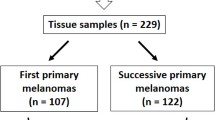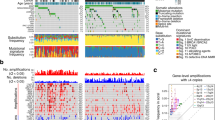Abstract
Purpose
In order to obtain better insight into the genetic background of nodular melanoma (NM), we aimed to analyse the frequency of CDKN2A and C-MYC copy number changes. The impact of these aberrations on the metastatic potential and patient’s survival was considered.
Methods
Fluorescent in situ hybridization was used to analyse the C-MYC and CDKN2A genes on isolated nuclei from 49 paraffin-embedded primary NMs.
Results
Thirty-six (73.47%) melanoma samples showed CDKN2A deletion while 11 of these 36 (22.45%) additionally displayed C-MYC increased copy numbers. Cases positive for metastases more commonly displayed CDKN2A deletions. However, the combined C-MYC and CDKN2A aberrations were found predominantly in the non-metastasizing group of primary NM. The survival analysis furthermore demonstrated that patients with combined CDKN2A and C-MYC aberrations have a significantly better prognosis than carriers of CDKN2A deletion only.
Conclusions
We conclude that the C-MYC increased copy number changes on the background of CDKN2A deletions seem to be related to a low metastatic potential and better patients’ outcome in primary NMs.


Similar content being viewed by others
References
Alonso SR, Ortiz P, Pollan M, Perez-Gomez B, Sanchez L, Acuna MJ, Pajares R, Martinez-Tello FJ, Hortelano CM, Piris MA, Rodriguez-Peralto JL (2004) Progression in cutaneous malignant melanoma is associated with distinct expression profiles: a tissue microarray-based study. Am J Pathol 164:193–203
Balch CM, Soong SJ, Gershenwald JE, Thompson JF, Reintgen DS, Cascinelli N, Urist M, McMasters KM, Ross MI, Kirkwood JM, Atkins MB, Thompson JA, Coit DG, Byrd D, Desmond R, Zhang Y, Liu PY, Lyman GH, Morabito A (2001) Prognostic factors analysis of 17,600 melanoma patients: validation of the American Joint Committee on Cancer melanoma staging system. J Clin Oncol 19:3622–3634
Bastian BC, Olshen AB, LeBoit PE, Pinkel D (2003) Classifying melanocytic tumors based on DNA copy number changes. Am J Pathol 163:1765–1770
Beahrs OH, Henson DE, Hutter RVP, Kennedy BJ (eds) (1992) Manual for staging of cancer. American Joint Committee on Cancer, 4th edn. J. B. Lippincott, Philadelphia
Cachia AR, Indsto JO, McLaren KM, Mann GJ, Arends MJ (2000) CDKN2A mutation and deletion status in thin and thick primary melanoma. Clin Cancer Res 6:3511–3515
Dang CV, Resar LM, Emison E, Kim S, Li Q, Prescott JE, Wonsey D, Zeller K (1999) Function of the c-Myc oncogenic transcription factor. Exp Cell Res 253:63–77
Demierre MF, Chung C, Miller DR, Geller AC (2005) Early detection of thick melanomas in the United States: beware of the nodular subtype. Arch Dermatol 141:745–750
Enders GH (2003) The INK4a/ARF locus and human cancer. Methods Mol Biol 222:197–209
Flores JF, Walker GJ, Glendening JM, Haluska FG, Castresana JS, Rubio MP, Pastorfide GC, Boyer LA, Kao WH, Bulyk ML, Barnhill RL, Hayward NK, Housman DE, Fountain JW (1996) Loss of the p16INK4a and p15INK4b genes, as well as neighboring 9p21 markers, in sporadic melanoma. Cancer Res 56:5023–5032
Fortes C, Mastroeni S, Sera F, Concolino F, Abeni D, Melchi F, Forastiere F, Pasquini P (2006) Survival and prognostic variables of cutaneous melanoma observed between 1995 and 2000 at Istituto Dermopatico Dell’Immacolata (IDI-IRCCS) Rome, Italy. Eur J Cancer Prev 15:171–177
Freier K, Bosch FX, Flechtenmacher C, Devens F, Benner A, Lichter P, Joos S, Hofele C (2003) Tissue microarray analysis reveals site-specific prevalence of oncogene amplifications in head and neck squamous cell carcinoma. Cancer Res 63:1179–1182
Glatz-Krieger K, Pache M, Tapia C, Fuchs A, Savic S, Glatz D, Mihatsch M, Meyer P (2006) Anatomic site-specific patterns of gene copy number gains in skin, mucosal, and uveal melanomas detected by fluorescence in situ hybridization. Virchows Arch (in press)
Grafstrom E, Egyhazi S, Ringborg U, Hansson J, Platz A (2005) Biallelic deletions in INK4 in cutaneous melanoma are common and associated with decreased survival. Clin Cancer Res 11:2991–2997
Greulich KM, Utikal J, Peter RU, Krahn G (2000) c-MYC and nodular malignant melanoma. A case report. Cancer 89:97–103
Grover R, Chana JS, Wilson GD, Richman PI, Sanders R (1998) An analysis of p16 protein expression in sporadic malignant melanoma. Melanoma Res 8:267–272
Jordanova ES, Riemersma SA, Philippo K, Giphart-Gassler M, Schuuring E, Kluin PM (2002) Hemizygous deletions in the HLA region account for loss of heterozygosity in the majority of diffuse large B-cell lymphomas of the testis and the central nervous system. Genes Chromosomes Cancer 35:38–48
Kelly JW, Chamberlain AJ, Staples MP, McAvoy B (2003) Nodular melanoma. No longer as simple as ABC. Aust Fam Physician 32:706–709
Kraehn GM, Utikal J, Udart M, Greulich KM, Bezold G, Kaskel P, Leiter U, Peter RU (2001) Extra c-myc oncogene copies in high risk cutaneous malignant melanoma and melanoma metastases. Br J Cancer 84:72–79
Kumar R, Smeds J, Lundh Rozell B, Hemminki K (1999) Loss of heterozygosity at chromosome 9p21 (INK4-p14ARF locus): homozygous deletions and mutations in the p16 and p14ARF genes in sporadic primary melanomas. Melanoma Res 9:138–147
Matsuta M, Imamura Y, Matsuta M, Sasaki K, Kon S (1997) Detection of numerical chromosomal aberrations in malignant melanomas using fluorescence in situ hybridization. J Cutan Pathol 24:201–205
Murray CS, Stockton DL, Doherty VR (2005) Thick melanoma: the challenge persists. Br J Dermatol 152:104–109
Palmieri G, Cossu A, Ascierto PA, Botti G, Strazzullo M, Lissia A, Colombino M, Casula M, Floris C, Tanda F, Pirastu M, Castello G; Melanoma Cooperative Group (2000) Definition of the role of chromosome 9p21 in sporadic melanoma through genetic analysis of primary tumours and their metastases. The Melanoma Cooperative Group. Br J Cancer 83:1707–1714
Peltenburg LT, de Bruin EC, Meersma D, Wilting S, Jurgensmeier JM, Schrier PI (2004) c-Myc is able to sensitize human melanoma cells to diverse apoptotic triggers. Melanoma Res 14:3–12
Poetsch M, Woenckhaus C, Dittberner T, Pambor M, Lorenz G, Herrmann FH (1998) Differences in chromosomal aberrations between nodular and superficial spreading malignant melanoma detected by interphase cytogenetics. Lab Invest 78:883–888
Ross DA, Wilson GD (1998) Expression of c-myc oncoprotein represents a new prognostic marker in cutaneous melanoma. Br J Surg 85:46–51
Sherr CJ, Weber JD (2000) The ARF/p53 pathway. Curr Opin Genet Dev 10:94–99
Straume O, Sviland L, Akslen LA (2000) Loss of nuclear p16 protein expression correlates with increased tumor cell proliferation (Ki-67) and poor prognosis in patients with vertical growth phase melanoma. Clin Cancer Res 6:1845–1853
Treszl A, Adany R, Rakosy Z, Kardos L, Begany A, Gilde K, Balazs M (2004) Extra copies of c-myc are more pronounced in nodular melanomas than in superficial spreading melanomas as revealed by fluorescence in situ hybridisation. Cytometry B Clin Cytom 60:37–46
Vaandrager JW, Schuuring E, Raap T, Philippo K, Kleiverda K, Kluin P (2000) Interphase FISH detection of BCL2 rearrangement in follicular lymphoma using breakpoint-flanking probes. Genes Chromosomes Cancer 27:85–94
Acknowledgment
We thank Aat Mulder for technical support. The work of D. Koynova study was supported by the Marie Curie Research Training Grant; Contract no. QLGA-CT-2000-60005 and by the grant of the Ministry of Education and Science—Upgrading Of Research Infrastructure no. 05/01.08.2005. N. Gruis is a recipient of an ASPASIA fellowship of the Netherlands Organization for Scientific Research.
Author information
Authors and Affiliations
Corresponding author
Rights and permissions
About this article
Cite this article
Koynova, D., Jordanova, E., Kukutsch, N. et al. Increased C-MYC copy numbers on the background of CDKN2A loss is associated with improved survival in nodular melanoma. J Cancer Res Clin Oncol 133, 117–123 (2007). https://doi.org/10.1007/s00432-006-0150-4
Received:
Accepted:
Published:
Issue Date:
DOI: https://doi.org/10.1007/s00432-006-0150-4




